The other day, I started up my old muscle car. This involves something more than pushing the “start” button – which is how you start pretty much every new car (the battery powered devices called EVs have an “on” button, kind of like a microwave or toaster).
The first thing was to set the choke.
This is something probably nine out of ten drivers under 30 have never done – because cars haven’t had chokes in 40-plus years. They have cold start enrichment circuits. A choke does the same thing (enrich the air-fuel mixture; i.e., more fuel relative to the air) but it generally has to be done manually – by pulling a choke knob out or by depressing the gas pedal before you try to start the engine (by turning the key, another thing we don’t do much anymore). 
Pulling out the knob or pushing down on the gas causes mechanical linkages to close the choke – which is a metal flapper door guarding the primary air inlet to the carburetor.
You also push some gas into the engine by pushing down on the gas pedal, which connects mechanically (via a cable) to the carburetor. In which liquid gas sits – in the bowl. Some gets squirted into the engine by this action, so there’s gas to burn (so the engine will start when you turn the key). You generally pump the gas pedal twice – to set the choke and squirt some gas into the engine.
In a fuel-injected car, electronically pressurized injectors automatically spray finely atomized fuel into the engine. This involves a lot of electronics – and a computer to govern it all. It usually works really well – until the day it doesn’t. A choke might stick. But you could unstick it.
Once the engine (in the old car) starts, you’d let it idle for a minute or so – to warm it up enough so that when you tapped the gas pedal again, the idle would settle down to normal rather than fast idle. Tapping the gas (after the engine’s had a minute or so to warm up) causes the choke to open, causing the engine idle speed to settle down to normal.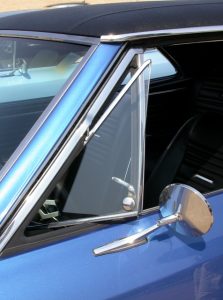
Now you’re ready to drive!
As you backed up out of the garage, you’d probably make adjustments to the heat – or AC if the car had AC. Until about the mid-90s, many new cars didn’t. AC was considered a luxury option. Only a few luxury cars had electronically controlled AC (and heat). If you didn’t have it, you moved a slide from “cold” to “hot” to adjust the temp. You could not specify exactly 72 degrees, say. But you also didn’t have to scroll through menus and it was easy to make close-enough adjustments without looking at the controls.
If you didn’t have AC, you might have had wing vent windows, which were triangular shaped sections of moveable glass you could open (and close) by hand to direct airflow into the car, which worked like a poor man’s AC.
Maybe you wanted to listen to some music. Turn on the radio – it might not have been a stereo – and up went the power antenna mast. These received radio signals; they didn’t receive “updates.” Or transmit anything, at all.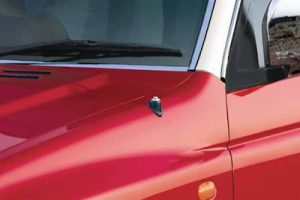
If you were driving at night and it was very dark, you might have used your left foot to turn the high beams on. The switch was located on the driver’s side floor, to the left of the brake and clutch pedal. So – in traffic – you’d sometimes have to do a little dance, engaging and disengaging the clutch and turning on and off the high beams.
Headlights generally didn’t come on at all – unless you turned them on. They also did not generally stay on when you turned them “off” (as they do with cars that have Daytime Running Lamps).
Back when we had a high trust society, most cars had exterior hood releases. You reached in the grille area, found the latch – and popped the hood. Then you’d be able to see the engine, which was not hidden underneath a plastic cover that made it look like every other engine. (It’s interesting to speculate whether the practice of covering engines with black plastic covers was conceived as a way to acclimate people to the homogenous look of battery powered devices.)
If the road was slick, you might have had to pump the brakes – so as to avoid a skid. The latter was something that happened when the brakes locked up the wheels and they stopped rotating. When they did, the car would skid in the same direction it was going – unless the driver had the presence of mind to let off the brakes and then steer the car out of the skid. Avoiding the skid in the first place was a matter of avoiding locking-up the brakes (and so, the wheels and so the tires) by applying them just shy of lock up and easing up before they locked up.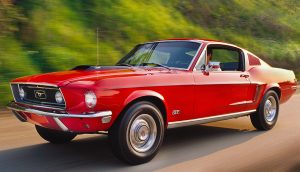
This was pumping the brakes.
That is now done by an ABS pump – and all the driver does is stand on the brakes. The pump prevents the car from skidding, but it does not prevent the car from failing to slow down fast enough to avoid running into the rear end of the car ahead the driver was following too closely. Many people have been encouraged to do that because their car has ABS – and they aren’t afraid of skidding into the car ahead of them. It doesn’t mean they won’t still hit the car ahead of them.
Which brings us to the main thing people used to do in their cars that many no longer do.
They drove them.
. . .
If you like what you’ve found here please consider supporting EPautos.
We depend on you to keep the wheels turning!
Our donate button is here.
If you prefer not to use PayPal, our mailing address is:
EPautos
721 Hummingbird Lane SE
Copper Hill, VA 24079
PS: Get an EPautos magnet or sticker or coaster in return for a $20 or more one-time donation or a $10 or more monthly recurring donation. (Please be sure to tell us you want a magnet or sticker or coaster – and also, provide an address, so we know where to mail the thing!)
If you like items like the Keeeeeeev T shirt pictured below, you can find that and more at the EPautos store!



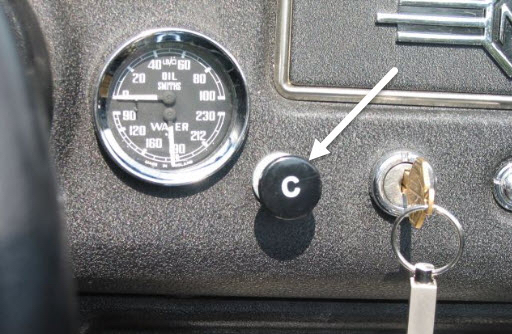

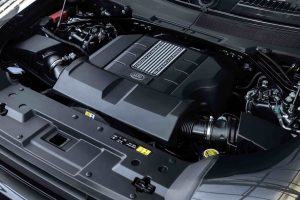







When I was a little kid I used to pretend my Western Flyer bike [Western Auto version of a Schwinn Sting Ray, banana seat and all] had a choke, which I would pull out and wait before starting off.
I’d seen my parents use the choke in the 53 Ford Customline they had when I was even younger.
That bike also had a pushbutton transmission like Granny’s 60 Ambassador wagon.
The car sickness has been lifelong.
The Valiant is out today for some errand running: metal dash, three speed on the column, unboosted steering an brakes.
I did have a Pertronix ignition installed over 20 years ago, starts like a fuel injected vehicle. I’d love a manual choke though. For real this time.
I had a Capri with a V6 way back around 1980. And it not only had the high beam stomp switch. But the switch also had a lower 180deg outer spring loaded momentary switch. Which would turn on the wipers. Which was a great addition as you didn’t have to use your hands to turn on and off the wipers while steering. 43 years later and I actually miss that foot selection function. And more than once considered sourcing one and installing it in my current NA Miata.
DD
Still have to remember to not pump the brakes on a car with ABS. And it’s been a while since I have even driven a car without ABS….. Frankly I could stop a car without ABS much better than one with it. It’s scary when that ABS is making that grinding noise and its not slowing fast enough….. Least it’s not often that I have it kick in, generally only when somebody else does something stupid and I have to panic stop….
Eric,
What was the procedure you mentioned on David Knight’s show some time back? Something like “tickle her teets”, and it had maybe to do with fuel delivery? The kids today would have no idea what you’re talking about? I sure didn’t.
Hi BaDnOn,
It’s tickle the Amals! See here: https://www.classicbritishspares.com/blogs/news/how-to-tickle-an-amal-carburetor
Thanks Eric!
That’s it! That had actually been bothering me for some reason. You never know when some bit of arcane knowledge will be of use.
Die Kupfer Ochse’s (the copper ox) 300-6 fired up easily in the single digit temperatures this past week. One pull of the manual choke knob and it rumbled to life. Snowy and icy roads are no problem for it is geared loooowwww. In first gear it just crawls and makes a very pleasing low whir. A heavy steel framed wooden floored flat bed aids in traction in 2wd. In 4wd the 45 year old ox will pull hard and is certainly very sure-footed.
From Eric: “The first thing was to set the choke.”
With my’78 Camaro Z28, with a tired engine, I would first crank
the engine and observe my installed oil pressure gage for the
correct oil pressure, then set the choke and fire the engine.
If I didn’t get oil pressure first, the rods would rattle.
I miss not being able to prime the engine, before starting,
on newer vehicles.
Ahhh, a metal dash MGB! Got one in the garage right now, and I last used the “strangler” a few days ago. Rochacha Q-Jets are good carbs, but those twin SU HS4’s, so very simple and easy to repair. For my money, a car with SU’s, or maybe a good Carter BBD (Super Six package on a Slant six for one), that’s easy maintenance motoring!
Metal dash indeed! And that round thing, kiddos, is a gauge set, oil pressure and coolant (water) temperature. You were expected to pay attention to these gauges lest bad stuff happen to your engine, your brain was the only computer on board.
“But I want a number!” No, you don’t. Analog gauge with a pointer allows instant recognition by your brain (pointing good, bad, heading the wrong direction). A number requires analysis – “Is 212 bad, or does it need to be 225 for bad? How about 192? What was that number a couple minutes ago?” Aircraft instrument flat panel displays often include emulated “steam gauges” just for this reason.
For some reason, the early 90s BMW K1100RS motorcycles had a choke despite being fuel injected.
I can say with the old diesels such as the 6.2 detroit ones from GM, there is no choke, but you have to put the accelerator down 1/2 way in warm weather to start with the same effect as a choke. Since it is mechanically injected, you are throwing more fuel in there than normal. Below freezing, you have to floor it to do the same. When its really cold, a full throttle start makes a glorious 12′ tall, 20′ long white cloud of unburned atomized diesel fuel out each cylinder bank to float around your block.
Heck I’m almost 40 and I’ve never done it
That pretty much disappeared by probably the early ‘80s.
I read about it in the book when I took drivers ed
Oldest cars I ever drove were a late ‘80s Jimmy and a late ‘80s Cutlass Ciera, neither of which required that.
My dad had an ‘84 Chevette diesel, it might have had a choke but if it did I think it was automatic
He had a Pinto before that, it might’ve had one but he traded that off a couple months after I was born so I can’t say I remember that one.
I have had exactly 2 cars with ABS. The ‘16 Honda is better than the ‘09 Toyota, but neither one is fantastic. I like it better without that “feature.”
Also, traction control doesn’t really do anything except make certain slippery situations even more difficult, and make it impossible to pop the clutch and spin the tires.
Off topic, haven’t heard from Nunzio (or Eightsouthman) lately. Hope they’re doing well.
That’s true, William. Nunz hasn’t posted in months. I hope they are both okay.
Thinking the same thing W.S. Definitely has left a gap on Eric’s site.
Hi William,
I miss those guys, too. I have both their private contact info; I will drop them a line.
Nunzio always had quality comments. Seems like a standup guy.
Have missed his commentary also, we both grew up in the NY/NJ metro area; although I’m a bit older it was fun comparing experiences.
Good morning, Mike!
I’ve emailed Nunz; trying to find Eight’s contact info…
Dang ep,
…Deja view, all over again! Historical reference.
The only time I ever had to use a classic choke nob was on my recently acquired 1983 “Ford Laser”..from a New Zealand used car dealer in Auckland Nov 1997.
Suzie and I were “in country” for the full 90 day visa.. and all the backpackers we met (a literal United Nations worth of experienced travelers ) urged us to outright “purchase” a vehicle in NZ.
We took their advice. Then set out on a 3,000+ mile plus odyssey throughout both N & S islands..
With the experience, I became accomplished in two new automotive handling techniques..
Right hand driving AND manipulating THE CHOKE NOB with a “dodgy” fuel intake assembly.
I had to wend my way through hordes of Christmas Holiday revelers on the way to New Plymouth, Mt Egmont/Taranka area, constantly manipulating the choke.
The vehicle was “Flogged” after nearly 3 months of usage, in Christchurch NZ…
We complained to the Authorities..and ended up as page 2 news with photo on “The.Press” Feb 10,1998?..I’m hanging over a parking meter and Suzie has a scowl on her face..
Our Andy Warhol moment consolation prize.
Last comment .. How to explain the geography of New Zealand?
Easy..Alaska had an affair with Tahiti and they named the kid New Zealand!
.
A new set of points, maybe a capacitor, snap off the distributor cap, change them out.
One thing you will need is a feeler gauge to set the points at the correct distance between the points.
You do everything you can to keep the wheels rolling.
I still use chokes regularly on all of my non-automotive engines (i.e. snow blower, lawn mowers, power washer, etc.). I figure most people with a yard and household to maintain (unless the property is very small) use similar equipment
My 1958 Ford tractor has a choke, starter button. The clutch pedal has to be depressed for the starter to work. Also has to be in neutral.
Two brake pedals, right and left, you can turn a sharper turn using one brake.
You have to learn how to drive it. Don’t get stuck in the mud.
Wheel weights on all four wheels.
For what it is, it is a strong tractor.
Kids growing up with cars today will be weak and dependent on others to maintain their appliances. Self sufficiency is going the way of the manual choke. This is not good for society at large. We’ve witnessed weakness and dependency aplenty over the last several years. The throwaway appliance era is detrimental to self sufficiency.
I have a feeling we will be forced back into an era of maintaining and reusing/repurposing very soon. And that’s a good thing.
My first car had a manual choke right behind the MANUAL 4 speed shifter on the console…..A 1972 Datsun 240Z…….Wish I still had it.
Thanks for the trip down memory lane! I had some great cars back in the day; some I wish I still had.
Oh yes, the joy of a flooded carb and having to hold open the choke to get it started.
Remember those days well but don’t miss those “automatic” chokes.
I’d much rather have a purely mechanical choke that I control. Lots of snow and cold the last week. The 1948 case VAC tractor with my plow has a manual choke. Starts right up. They just don’t make em’ like that anymore.
Having to “unstick” an automatic choke. Good memories. 1:27 mark for the “how to”:
https://youtu.be/7_yzFc1rusI?si=_2ebLw9hen0VWcaH
Hi Gomer,
The thermostatic (coil) chokes used on Rochester carbs work very well (and reliably) in my experience. The only (small) issue I have with my carbureted Trans-Am when I try to start it after it’s been sitting for a few weeks is having to crank it a bit – in order to get gas back into the carb. Q jet wells leak – even after you epoxy ’em!
Time for an electric fuel pump.
That way you can get fuel up to the carb without the extended cranking necessitated by the mechanical fuel pump.
So funny how things don’t work as intended when they are no longer used per design intent.
Back in the day, it would have been rare to have a carb’ed car sit long enough to evaporate much fuel from the bowl.
With an infrequently driven classic like the Trans Am, we now have “new” problems like your extended cranking.
I finally got the electric choke on my Edelbroke carb set up and working well on my Firebird. It starts well in cold temps now. Although I would much prefer a manual choke. I always worry that the electric choke will fail to open all the way, and the only way to make sure it is is to take off the air cleaner and look.
I used to do pick up manual choke kits for most of my cars after the automatic chokes would get crotchety. All sorts of goodies were available from J.C. Whitney, Pep Boys, etc. My ’68 Impala got cruise control and intermittent wipers that way, too. Cruise control worked by maintaining RPM by counting ignition cycles. It worked in all but really hilly country.
The Impala’s 327 even became a 163.5 for a while during the ’70 gas crunch, but the hill heading into Huntsville made me turn it back into a V8.
My 79 Pontiac Q Jet had a screw adjustable vacuum pull off, made for an easy fine tuning of the choke blade for just right cold running. It also had the hot air coil not electric heated coil, again adjustable tension for longer or shorter choke time. I then added an adjustable cold air bleed to the hot air feed to the choke coil, so I could keep a lighter choke coil setting but extend the time to coil “off”. By 79 GM had removed the power valve from the primary side carb feed and the resulting damn cold bog was a real annoyance. It took way longer for the manifold and carb base to heat up than for the choke to warm to “off”, emissions first even back then. My finagling pretty much eliminated the bog but prevented over rich during warm up.
You youngins have a bunch of research to do, to understand anything I just wrote. Eric and others that grew up with, or currently own, a carbed engine know all this stuff. Next history lesson “carb icing”, see GM early ‘70s small block two barrel with iron intake manifold. I bought a lot of Iso Heat for The Commanders ‘71 Nova during the winter.
The Auto-chokes I played with had a lever release when full throttle to ease starting a flooded engine.
I remember the auto choke on my Nova worked fairly well except on damp/foggy mornings. Then you had to stick a screwdriver into the carburetor to hold it open while starting the car. Sometimes you also had to take off the distributor cap and wipe down the inside to get it dry. Good memories.
I’m used to most of that kind of stuff based on which one of my cars I drive. Heck even my snow blower has a choke and primer bulb. 🙂
I watched a video from a Toyota specialty shop that explained exactly how A.S.S. worked and how it interacted with a lot of the car’s systems. From outside temperature to whether a door was open and all I could think was “And that’s why we can’t have nice stuff.”
Everything new is like that now; as a buddy explained that you can’t pirate video games now because they need to be online to work or your car’s computer being bricked due to a failed update.
Thanks but no thanks. While I do agree that current vehicles have gone way overboard with technology, I’ll take a 90’s/early 2000’s with fuel injection over a carburetor every day of the week. I was ok with the manual chokes that were common till the late 60’s, but the automatic chokes were garbage. Never worked for very long and they were a bitch to get adjusted properly. Sure, maybe you could unstick it yourself, or easily replace mechanical bits like a distributor cap/rotor. Sounds like fun when it’s 7 degrees outside, snowing, I don’t have a garage, and I’m already late for work. I know you love your Trans Am Eric, but I started driving in 1966. I owned many many 50’s, 60’s and 70’s cars long before they were cool antiques. I was there. Trust me, the vast majority of cars from that period were hot garbage. Most of them were ready for the junkyard after 3 or 4 years. Replacing starters, alternators, water pumps, mufflers was an annual event, not to mention constant tuneups and adjustments. While us car guys might enjoy that kind of tinkering, most people don’t have the time or ability to be bothered with that. The new stuff is overly complex, yes, but it’s a hell of a lot safer, more reliable, more durable, and more comfortable. I would suggest that the younger posters here go find an original 60’s car with manual 4 wheel drum brakes, no power steering and a 3 speed on the column. Take that for a test drive and understand that back then it was even worse because originally it would have had bias ply tires which probably aren’t even available anymore. I promise you’ll have a newfound appreciation for your current appliance on wheels. Maybe you can’t fix it yourself anymore, but you don’t have to! Modern cars will easily go 10 or 12 years with no problems. Cars from the 60’s and 70’s were lucky if they went 6 months without something breaking. When I was a kid, my mother was a single mom. The Chevy dealer was a regular part of our life. Her car was in there 8 or 10 times a year for repairs. Other than maintenance, I haven’t needed a “repair” in well over 20 years.
Dad installed a manual choke into his Grand Torino. Not sure why but he was always old school.
Never got to drive a column shift and I’m glad for that. Seemed so awkward to me.
Hey Dan. Probably because the auto chokes never worked right. And if you did get it working, it wouldn’t last very long.
Column shifted manuals aren’t too bad when their in excellent shape but when their worn out and loose that’s when the fun begins…..
“Three on the tree” works fine for a basic sedan or pickup that’s simple. The worst part was sometimes the shifter got sloppy, and you’d have to spend an afternoon, pulling off the steering wheel, grinding the shift tube end square, and probably replacing a worn bushing amd spring. Not fun. By 1970, all cars went to that ignition lock in the steering column, with having to “park” the car in reverse, and you also had to push the clutch ALL THE WAY IN for the starter to engage. All in the name of “safety” and theft deterrence, but, man, it made for a lot of ways failure could happen!
Also, cars needing to be “adjusted” or tuned wasn’t necessary a big problem…often some guy that ran a nearby gas station also did tuneup or brakes, and if he was competent, honest, and reasonably priced, it wasn’t that bad. Once cars not only became far more complex, but also, the auto makers made more things “proprietary”, only fixable via the “stealership”, independent garages began disappearing. But cars had to become “maintenance free”, because they got a LOT more expensive, requiring longer terms of finance, which in turn meant the finance companies (like Ford Credit or GMAC) didn’t want to repo junkers
At least with “old school”, the owner had a reasonable chance to maintain it HIMSELF. Virtually impossible now. If nothing else, many states or municipalities all but FORBID it, and, good luck getting rid of used oil and spent coolant…unless you want a huge fine and a nice, comfy stay in a “pound ’em in the ass” prison for illegal disposal of “hazardous” materials.
Hi Floriduh,
I don’t dispute the gist of what you’ve written here. But I would add that while those “classic” cars did need more attention (and not infrequently inconveniently) they were so inexpensive – in beater form – that a teenaged kid could easily afford one. And a teenaged kid with some brains and gumption could learn to fix ’em. This I know – because I was there! When I was a teen/young adult in the ’80s, almost all of us kids had cars; most were (as you note) pieces of shit. But they were our pieces of shit – and we were on our way to being adults.
I continued to drive a thrashed VW Beetle to work and back when I worked at The Washington Times, before I began to get new cars to test drive. I paid $700 for the Beetle and sold it for about the same. Yes, it occasionally broke down. But I was always able to fix it, myself – often right there by the side of the road!
New cars are more reliable and (in general) much better built. But they are also much more expensive and that includes paying the cost of the repairs most can’t do anymore!
Had a VW van. Fun Fun Fun,,, A real girl catcher and parts to rebuild available from J. C. Whitney via US Mail! You could really trick one out.
Adjusting the Auto-Choke easy peasy. Center the Rotatable cover. Rotate until it just started to move then back off a half a mark to Lean. That usually got it close enough.
Rubber bushing on column shift easy to replace about once every 10 years. Drum brakes about once every 20,000 miles.
Oil change every 2500 miles.
Points filed about the same,,, 2500 miles. Change w/new condenser about once every 10,000.
Antifreeze every 2-3 years.
To me at the time, it was fun.
Antifreeze? Column shift bushing? On a VW?
My thought exactly.
Everybody makes mistakes.
A Beetle was a cold ride in vinter, a gasoline heater was available for sale as an add on, they were a fire danger.
A good old friend owned a Beetle for over 40 years, had two, one burned up at a body shop that happened to go afire.
Traveled to another city 600 miles away, driving it back, had drivetrain failure. Fixed the problem, spent another 1500 to get it back home.
Always was having work done for one reason or another, an engine rebuild, all sorts of repairs.
Cost him an arm and a leg, didn’t matter.
He could have bought three new vehicles for the money spent on one VW Beetle.
In the 70s, I had a VW bug, which I got for $100, the previous owner forgot to put oil in it!!! Rebuilt the engine with parts from J. C. Whitney. You could fix just about anything then by following the Chilton shop manual. Still wish I had that car now.
I thought VW bugs were all air cooled?
My dad had a 62 VW van, 23 window with the sliding sunroof, two tone red / white. Have you seen the prices for these things, my brother and I about passed out! Oh the classics we let slip away! Dad’s VW van, my ‘63 and ‘69 Alfa Romeos, brother’s ‘67 gold / black vinyl roof GTO.
If you were in a jamb for money, the “file it” zero dollar tuneup always an option! Pull those plugs, clean off the gunk, regap and install. If the porcelain parts were intact good for another 10k miles. Points? Sand or file off the deposits square them up set the gap good to go. The best was the external adjust GM points, hook up a dwell meter set the dwell while running – perfect! Ever see a spark plug sand blaster? Those were the days!
Lawd I miss the wing vent. Sigh.
WRT the choke –the arrested development part of my personality instantly thought of Porky Pig repurposing Daffy Duck as his car engine. Every time Porky would pull the choke it would literally choke Daffy.
I believe animator Mike Maltese once quipped that originally they wanted the zany character that became Daffy to be a CHICKEN…given the ensuing frustration on Porky’s part, he’d have ended up “CHOKING THE CHICKEN”.
Methinks the Hays board would have censored THAT charachter!
RE: ABS. Wednesday and Thursday morning were the first big weekday storms of the season. Headed home Wednesday went mostly well, only took twice as long, but at least no stops. Thursday morning right out of the garage I got behind a hesitant driver. Ten under PSL, which was 25 MPH, then 35, right down the middle of both lanes. Modern Subaru with AWD and traction control and ABS, completely unnecessary for this driver who would probably panic if the wheels spun even for a second.
As soon as practical I put the V6 to good use.
I’ll never understand the paralyzed winter driver. Keep your distance and wits about you of course, but I consider it great fun to drive in snow. Find an empty parking lot and practice. Get the feel of a skid and how to steer your way out. Like driving on ball bearings, if you can get good at driving on snow you’ll be able to handle most anything.
You are one of the few others that like driving in the snow. A friend and I would drool at the chance to go out and turn local parking lots into personal fun parks.
Oh boy, another dinosaur convention, lol! Yesterday was only 1 repair, a Ford Fusion blower resistor repair $400.00. I remember the REAL blower resistors which were different thickness wire coils, that had different ‘resistance’ and thus made the separate fan speeds, and were $10.00 to replace, in under 15 minutes. Now it takes 2-3 hours of being upside down under a dash, rewiring burnt out connectors as well as digging out the solid-state ‘gold nugget’, to have a working heater blower again.
New cars are hideously painful to fix anymore.
Amen brother. I changed out the 401 nail head in my 66 Buick wildcat, start to finish, in 4 hours. Drain and pull the radiator. Unbolt the ac compressor and lay it aside. Pull and plug the fuel line before the pump. Pull the wiring harness (about 10 connections which obviously fall naturally in their intended place. Pull the throttle cable, the starter, the motor mount bolts, and the bell housing bolts. Attach a chain diagonally across the intake manifold and yank that sucker. It was about 1988 and I remember it as a great fun day.
Today I’m lucky to get a fan clutch off in less than an hour. And it’s just not fun.
In the 1992 film, “Mr. Baseball”, the aging ex-Yankee first baseman, Jack Elliot (Tom Selleck), traded to the Chinuchi Dragons of the Japan Central League, is advised by a fellow American expatriate ballplayer that the Japanese umpires are biased against the “Gaijin”, giving them, when batting against a native pitcher, “A strike zone the size of a BUICK”. Rather ample space in the engine bay of that 1966 Wildcat, and helped by the Nailhead being quite narrow for a V8.
JFC, wow! That and the Ford water pump buried behind the timing / cam chains. Progress Comrades! The clinker on my ‘03 Escape is the alternator buried down and behind the V6 engine. Factory service method requires removal of the RH drive shaft to get the alternator out, hours of work. My ‘91 Chev small block 350 if it takes 10 minutes to pull the alternator you’re a slow poke.
The same motor is in the Ford contour, but only the RH axle has to come out to get the alternator out. If you have the 4WD V-6 Escape, the alternator is buried between the exhaust and the AWD Transfer case as well. I took one look at that for a customer, and said, NOPE!
‘If you didn’t have [climate control], you moved a slide from “cold” to “hot” to adjust the temp.’ — eric
This remains normal life for those of us who drive vintage vehicles. Another slide controls a door in the ductwork, determining the split of forced air between the dashboard vents and the ones that blow on the floor.
To a gearhead, it is logical, proper and pleasing to work mechanical levers which control the flow of cooling water to the heater core and air to the vents, just as an organist has a large array of controls over the stops. It is an art, and though it could be automated, it shouldn’t be.
Whereas the ‘cell phone on wheels’ aesthetic caters to technophobes who just want to set a digital display to 72, and not be bothered with the uncouth goings-on down in the plumbing and duct work.
This is an utterly alien mindset to me. I refuse to be assimilated. And I have no interest in their ‘devices,’ other than lifting my hind leg to direct a steaming golden stream on them.
In addition, carbs were easily accessible and couldbe disconnected/unbolted for work table maintenance. Carb rebuild kits were required after awhile.
The replacement of ignition points, rotor, condenser and spark plugs were considered normal maintenance as well and it was quite enjoyable to perform.
Lastly, getting out the timing light and manually turning the distributer, in order to achieve perfect timing with the crankshaft!
Then…actually DRIVING THE VEHICLE!!!